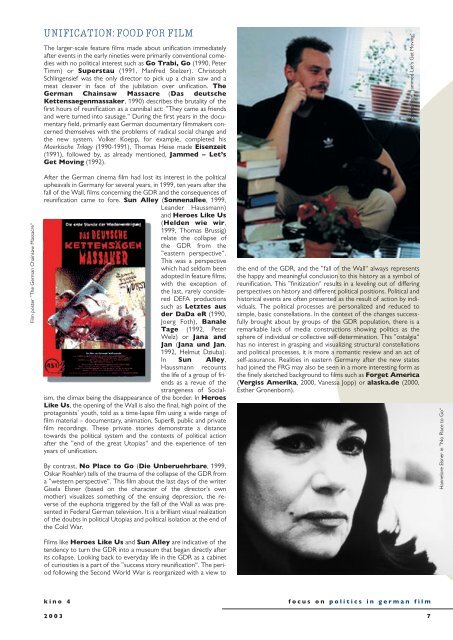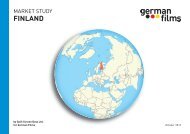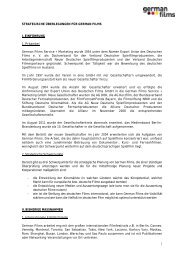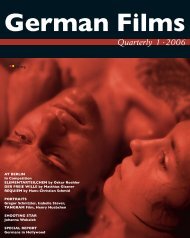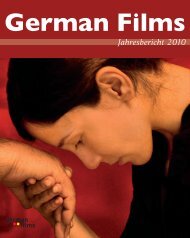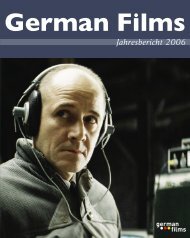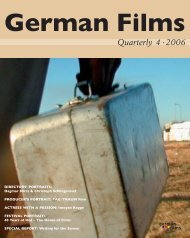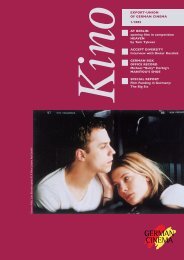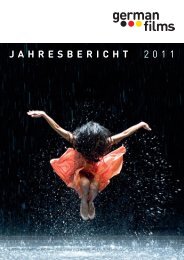Kino - german films
Kino - german films
Kino - german films
Create successful ePaper yourself
Turn your PDF publications into a flip-book with our unique Google optimized e-Paper software.
Film poster ”The German Chainsaw Massacre“<br />
UNIFICATION: FOOD FOR FILM<br />
The larger-scale feature <strong>films</strong> made about unification immediately<br />
after events in the early nineties were primarily conventional comedies<br />
with no political interest such as Go Trabi, Go (1990, Peter<br />
Timm) or Superstau (1991, Manfred Stelzer). Christoph<br />
Schlingensief was the only director to pick up a chain saw and a<br />
meat cleaver in face of the jubilation over unification. The<br />
German Chainsaw Massacre (Das deutsche<br />
Kettensaegenmassaker, 1990) describes the brutality of the<br />
first hours of reunification as a cannibal act: ”They came as friends<br />
and were turned into sausage.“ During the first years in the documentary<br />
field, primarily east German documentary filmmakers concerned<br />
themselves with the problems of radical social change and<br />
the new system. Volker Koepp, for example, completed his<br />
Maerkische Trilogy (1990-1991), Thomas Heise made Eisenzeit<br />
(1991), followed by, as already mentioned, Jammed – Let’s<br />
Get Moving (1992).<br />
After the German cinema film had lost its interest in the political<br />
upheavals in Germany for several years, in 1999, ten years after the<br />
fall of the Wall, <strong>films</strong> concerning the GDR and the consequences of<br />
reunification came to fore. Sun Alley (Sonnenallee, 1999,<br />
Leander Haussmann)<br />
and Heroes Like Us<br />
(Helden wie wir,<br />
1999, Thomas Brussig)<br />
relate the collapse of<br />
the GDR from the<br />
”eastern perspective“.<br />
This was a perspective<br />
which had seldom been<br />
adopted in feature <strong>films</strong>,<br />
with the exception of<br />
the last, rarely considered<br />
DEFA productions<br />
such as Letztes aus<br />
der DaDa eR (1990,<br />
Joerg Foth), Banale<br />
Tage (1992, Peter<br />
Welz) or Jana and<br />
Jan (Jana und Jan,<br />
1992, Helmut Dziuba).<br />
In Sun Alley,<br />
Haussmann recounts<br />
the life of a group of friends<br />
as a revue of the<br />
strangeness of Socialism,<br />
the climax being the disappearance of the border. In Heroes<br />
Like Us, the opening of the Wall is also the final, high point of the<br />
protagonists’ youth, told as a time-lapse film using a wide range of<br />
film material – documentary, animation, Super8, public and private<br />
film recordings. These private stories demonstrate a distance<br />
towards the political system and the contexts of political action<br />
after the ”end of the great Utopias“ and the experience of ten<br />
years of unification.<br />
By contrast, No Place to Go (Die Unberuehrbare, 1999,<br />
Oskar Roehler) tells of the trauma of the collapse of the GDR from<br />
a ”western perspective“. This film about the last days of the writer<br />
Gisela Elsner (based on the character of the director’s own<br />
mother) visualizes something of the ensuing depression, the reverse<br />
of the euphoria triggered by the fall of the Wall as was presented<br />
in Federal German television. It is a brilliant visual realization<br />
of the doubts in political Utopias and political isolation at the end of<br />
the Cold War.<br />
Films like Heroes Like Us and Sun Alley are indicative of the<br />
tendency to turn the GDR into a museum that began directly after<br />
its collapse. Looking back to everyday life in the GDR as a cabinet<br />
of curiosities is a part of the ”success story reunification“. The period<br />
following the Second World War is reorganized with a view to<br />
the end of the GDR, and the ”fall of the Wall“ always represents<br />
the happy and meaningful conclusion to this history as a symbol of<br />
reunification. This ”finitization“ results in a leveling out of differing<br />
perspectives on history and different political positions. Political and<br />
historical events are often presented as the result of action by individuals.<br />
The political processes are personalized and reduced to<br />
simple, basic constellations. In the context of the changes successfully<br />
brought about by groups of the GDR population, there is a<br />
remarkable lack of media constructions showing politics as the<br />
sphere of individual or collective self-determination. This ”ostalgia“<br />
has no interest in grasping and visualizing structural constellations<br />
and political processes, it is more a romantic review and an act of<br />
self-assurance. Realities in eastern Germany after the new states<br />
had joined the FRG may also be seen in a more interesting form as<br />
the finely sketched background to <strong>films</strong> such as Forget America<br />
(Vergiss Amerika, 2000, Vanessa Jopp) or alaska.de (2000,<br />
Esther Gronenborn).<br />
kino 4 focus on politics in <strong>german</strong> film<br />
2003 7<br />
Scene from ”Jammed-Let’s Get Moving“<br />
Hannelore Elsner in ”No Place to Go“


